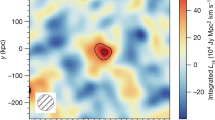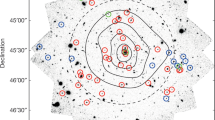Abstract
To understand the physical processes which controlled the formation of individual galaxies and clusters of galaxies, it is very important to determine the relative numbers of clusters over a wide range of masses. Although this present day clustering spectrum may not perfectly match the primordial spectrum, one hopes that the major features of the latter might be deduced from the observations. For the massive end of the clustering spectrum, the catalogue of Abell1 can be analysed to provide the necessary data2. For the faint end there are many problems, both observational and theoretical. The observational problems arise if attempts are made to specify group or cluster membership when insufficient data are available. These problems can be avoided by using a complete redshift survey. We have previously presented a large redshift survey of galaxies in a 260 deg2 region of the sky in the direction of the rich clusters Coma and A1367. We found eight groups and clouds which lie in the 4.2 × 104 Mpc3 (assuming H0 = 50 km s−1 Mpc−1) between the local supercluster and the Coma/A1367 supercluster. We use this new survey data here to determine the low mass portion of the clustering spectrum.
This is a preview of subscription content, access via your institution
Access options
Subscribe to this journal
Receive 51 print issues and online access
$199.00 per year
only $3.90 per issue
Buy this article
- Purchase on Springer Link
- Instant access to full article PDF
Prices may be subject to local taxes which are calculated during checkout
Similar content being viewed by others
References
Abell, G. O. Astrophys. J. Suppl. 3, 211 (1958).
Chincarini, G. Nature 274, 452–454 (1978).
Gregory, S. A. & Thompson, L. A. Astrophys. J. (in the press).
Doroshkevich, A. G., Sunyaev, R. A. & Zeldovich, Ya. B. in IAU Symp. No. 63 (1974).
Rees, M. J. & Ostricker, J. P. Mon. Not. R. astr. Soc. 179, 541 (1977).
Thompson, L. A. & Gregory, S. A. Astrophys. J. (in the press).
Malmquist, K. G. Meddn Lunds astr. Obs. Ser. II, no. 22 (1920).
Tifft, W. G. & Gregory, S. A. (in preparation).
Gott, J. R. III & Turner, E. L. Astrophys. J. 26, 357 (1977).
Tifft, W. G. & Gregory, S. A. in IAU Symp. no. 79 (in the press).
Field, G. B. in Galaxies and the Universe (eds Sandage, A., Sandage, M. & Kristian, J., 359 (University of Chicago Press, 1976).
Silk, J. Astrophys. J. 151, 459 (1968).
Weinberg, S. Gravitation and Cosmology (Wiley, New York, 1972).
Jones, B. J. T. Rev. mod. Phys. 48, 107 (1976).
Liang, E. P. T. Mon. Not. R. Astr. Soc. 180, 117 (1977).
Author information
Authors and Affiliations
Rights and permissions
About this article
Cite this article
GREGORY, S., THOMPSON, L. Low mass portion of the galaxy clustering spectrum. Nature 274, 450–452 (1978). https://doi.org/10.1038/274450a0
Received:
Accepted:
Issue Date:
DOI: https://doi.org/10.1038/274450a0
This article is cited by
-
Galaxy clustering spectrum and cosmic luminosity
Nature (1978)
Comments
By submitting a comment you agree to abide by our Terms and Community Guidelines. If you find something abusive or that does not comply with our terms or guidelines please flag it as inappropriate.



